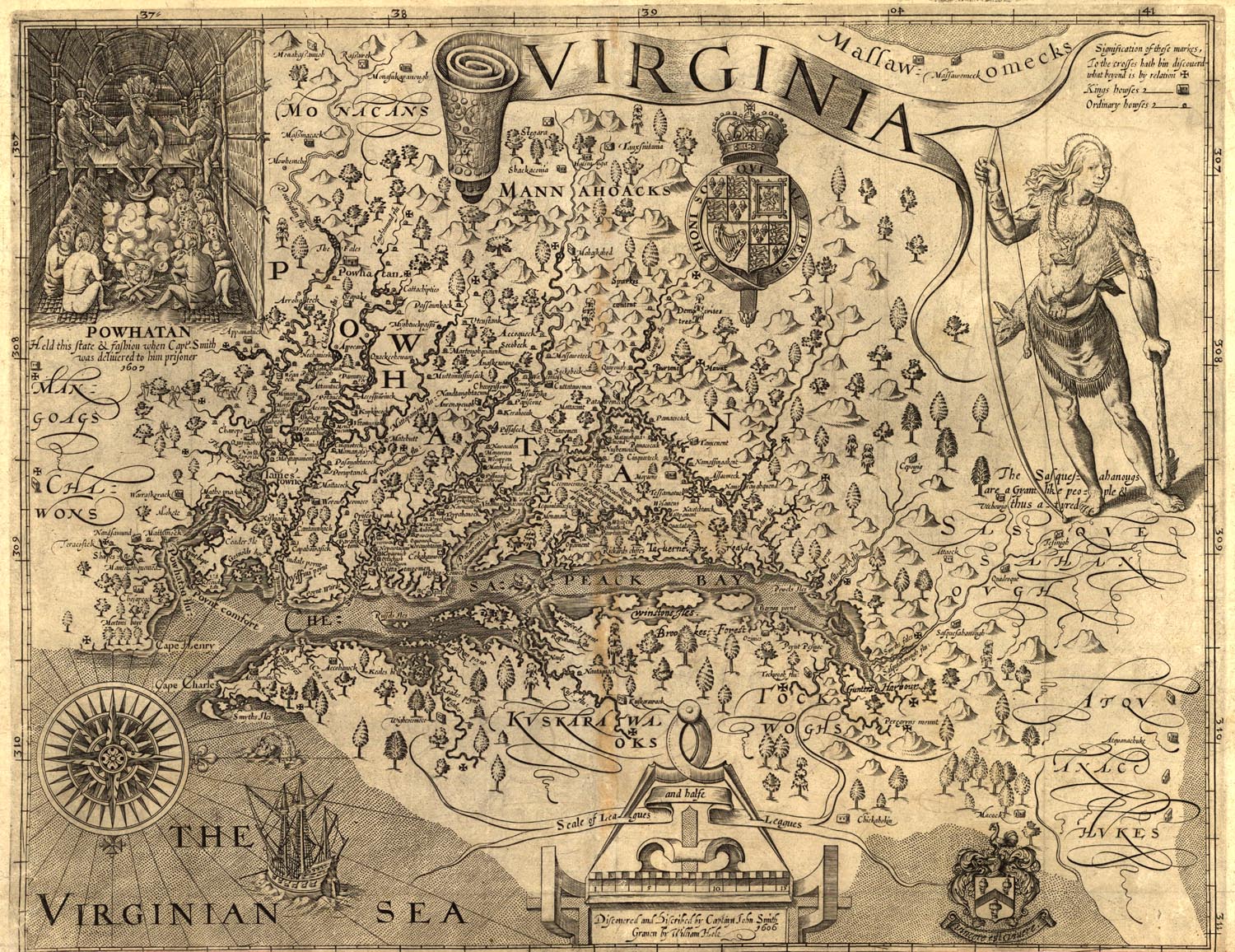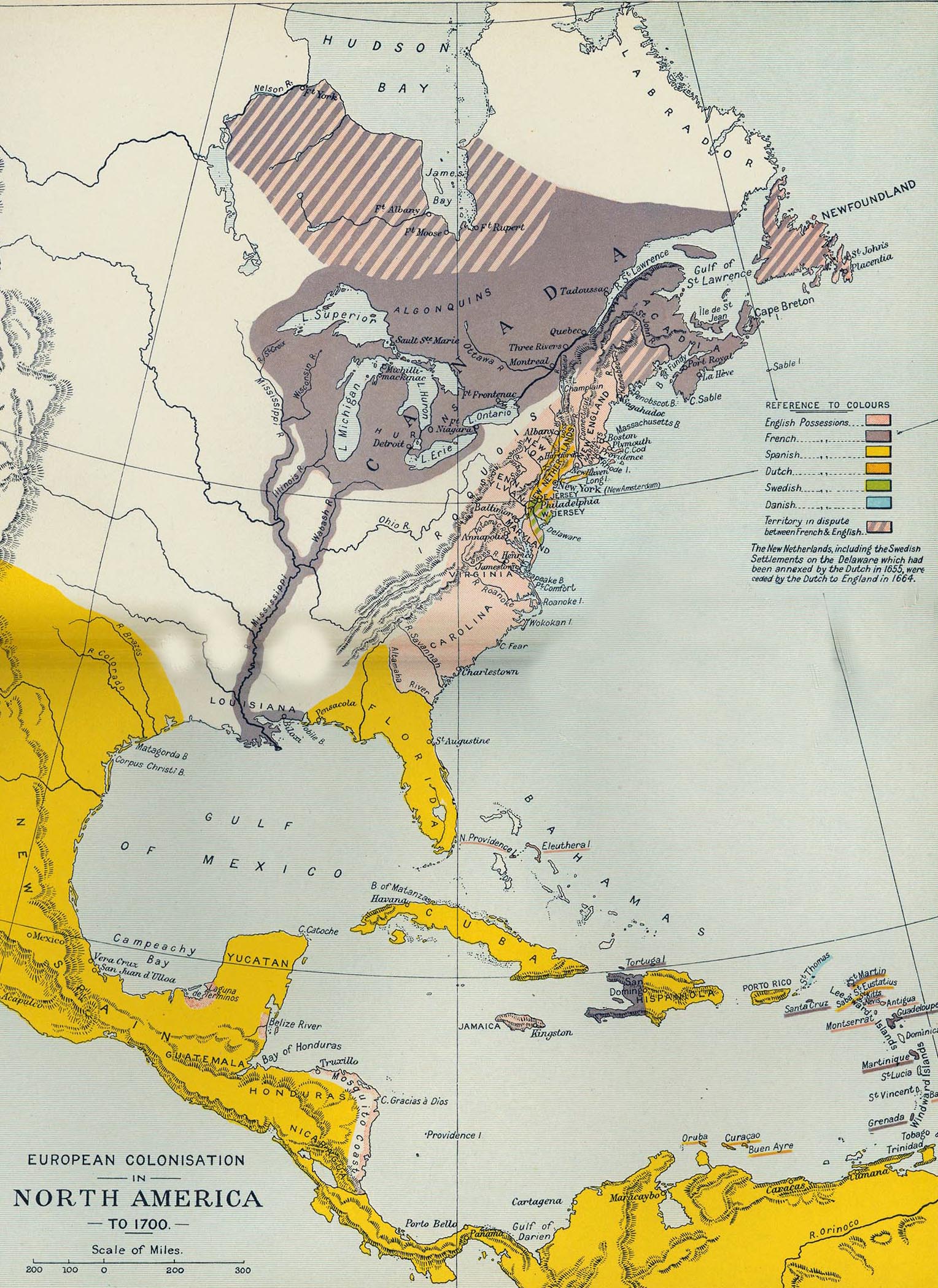
Captain Smith's Map of Virginia. It is oriented with the west to the top, and north to the right.
- Virginia (1607): The first attempts of the English crown in the New World came in the form of raids against Spanish holdings – Sir Francis Drake in 1570-1572, for instance. Eventually, a desire came to plant a colony so as to gain gold and an economic foothold in the New World. The first hurrah came with the Sir Walter Raleigh organized colony at Roanoke (NC) in what they dubbed “Virginia” for Queen Elizabeth I of England. This was set up in 1587, but disappeared before the return trip of supplies in 1590. The name Virginia, however, stuck for much of the East Coast at this point – as Florida was the Spanish name (1571, Spanish Jesuits in Virginia, but martyred.) The check of Parliament prevented crown funded expeditions, so the Virginia Company, with two parts, the London & Plymouth Companies, set forth. The London Company got what ended up being Virginia – in 1607 Jamestown was established in modern Virginia, and so the colony was born. This small group lost 2/3 of their colonists in the first eight months to sickness and the like. John Smith and his hard discipline kept them alive, and the discovery of Tobacco kept an economic reason for the colony. It received two new charters, in 1609 and 1612, but never really achieved its goals. Slavery and an elected assembly both arrived in 1619. After the devastating Indian attacks by the Powhatan Confederation in 1622 (1/4 of colonists killed) and the disinterest of the stockholders, however, Virginia was made a royal crown colony in 1624 by King James I. This would pretty much assure its survival, and the final destruction of the Powhatan. The capital would remain at Jamestown for most of the rest of the century, and in 1634 the colony would be divided into “shires” or Counties. The crown would keep the colonial assembly, called the House of Burgesses.
- Bermuda (1612): The island of Bermuda, sitting off the east coast of the modern United States would also become part of the British colonial empire – founded in 1612, and made a royal colony – a status it still holds – in 1684.
- Plymouth Colony (1620): Most Americans are familiar with this colony above all others – this is the location of the Pilgrims we all drool over on Thanksgiving. The Pilgrims were a radical Calvinist group that had left England in 1609 for the Netherlands, but wanting a place of their own, set forth on the Mayflower in 1620 to found the Plymouth colony, which would be independent and generally self governing until it was merged with Massachusetts Bay colony to found the royal colony of Massachusetts in 1691.
- Barbados (1627): The oldest British holding in the Caribbean, Barbados was significant for the foothold it provided the crown in the south. The sugar revenue of this tiny island was extremely valuable.
- Massachusetts Bay (1629): This was the largest and most significant of the colonies in New England, settled by Calvinst Puritans, although not as radical as the Pilgrims. This colony started at Salem in 1629 and quickly incorporated the territory of Boston. To the North, a few colonists settled in what would become New Hampshire in 1623, but would soon fall under the jurisdiction of MA Bay.
- Maryland (1634): Unique amongst the colonies of the coast, Maryland was founded by a charter from King Charles I of England to George Calvert, Lord Baltimore, making the first proprietary colony that got off the ground. The English Catholic Calverts, originally given Newfoundland, could not stay in Virginia as they could not take the Oath of Supremacy. Calvert asked for a new grant to be named “Maryland” for the Queen, and his son Cecilius Calvert actually received the charter in 1632 for the territory north of the Potomac, and including the river, and south of what is basically the Mason-Dixon line today (the 40th parallel, but Philly later…). This was supposed to be a refuge for Catholics (although they had to be smuggled past the port officials administering the Oath of Supremacy), and although Jesuits helped organize the expedition, Catholics remained a minority. They landed in 1634, Mass was said on St. Clement’s Island, and they established the capital at St. Mary’s City in southern Maryland. There was a fight against Virginians living in this territory – Claiborne, for one resisted, although without success. In 1649 the Calverts formalized the Toleration Act, so that Catholics could freely practice. Fleeing Puritans, though, during the English Civil War and after soon took control and repealed the act.
- Connecticut (1636): This colony was merely an offshoot of the Massachusetts Bay colony. MA Bay allowed a group of settlers from MA Bay, under the leadership of Puritan Rev. Thomas Hooker to settle and govern the area around Hartford, Connecticut, on the Connecticut River. This, of course, annoyed the Dutch.
- Rhode Island (1636): Another offshoot of MA Bay, this time founded by a religious outcast, Rhode Island was originally a loose conglomeration of towns. Roger Williams is considered the primary founded, and established Providence in 1636. Portsmouth followed in 1638, Newport in 1639, and finally Warwick in 1643 make up the full colony. The 1644 charter allowed these four towns to be self-governed. In 1663 they received another, from King Charles II, that gave them self governance as the Colony of Rhode Island and Providence Plantations. Religious freedom was guaranteed – it was viewed as a moral sinkhole of outcasts.
- New Haven (1638): This colony on Long Island Sound was founded by London Puritans seeking a trading post. This was a weak and poorly governed colony hemmed in by unfriendlies: the Dutch & CT. Eventually, given the choice, they were absorbed by CT in 1664, rather than NY.
- We might note, too, that in the early 17th century (1638) the English pirates got a foothold on a neglected section of the Central American Coast: British Honduras, now called Belize. It would be subordinated to the government of Jamaica in 1742.
- Jamaica (1655): This large Caribbean island would be captured by the English from Spain in 1655. This would be a martial and commercial outpost of some importance – by far the largest Caribbean island colony of England. This, too, is the only major addition to the English colonial Empire under the Cromwellian rule. Not until the restoration of the king in 1660 does the numbers of new colonies again increase.

European Colonization up to 1700.
Sources: American Colonial and Revolutionary History by Smelser, Colonial American Troops by Chartrand; The Columbia Encyclopedia.
Live well!
Nice work - thanks for putting this together. I am particularly interested in this post about Maryland: "...although they had to be smuggled past the port officials administering the Oath of Supremacy..." In St. Mary's City, one of the docents stated that all passengers on the Ark and Dove took the oath. This was followed by some debate on whether the boats were forced to turn around early in their journey and return to port when officials had discovered that some had not taken the oath. Have you heard about this? If not, can you point me in a direction to read more about this? Thanks again!
ReplyDeleteSorry for my greatly delayed reply. I am glad you enjoyed the post! My source on the procedure for the oath taking was a summary of early American history by Marshal Smelser entitled "American Colonial and Revolutionary History." He seems to draw upon a source of C. C. Hall, ed. "Narratives of early Maryland" published in 1910. Sadly, I don't know of a great book on these aspects of early Maryland, though I wonder if the accounts of Fr. Andrew White, SJ make any mention.
ReplyDelete